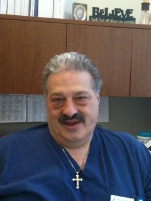 Administrator of Jefferson Surgical Center at the Navy Yard Joseph DeMarco discusses why his center decided to incorporate the Navio robotic system into his center and how the technology could impact ASCs going forward.
Administrator of Jefferson Surgical Center at the Navy Yard Joseph DeMarco discusses why his center decided to incorporate the Navio robotic system into his center and how the technology could impact ASCs going forward. Q: Why did you decide to consider a robotics program for your surgery center?
Joseph DeMarco: The robotics program was requested by one of our surgeons. The surgeon believes that partial knee replacement is the right format for the ASC and the robotic technology allows for the precision that he needs in this type of procedure. Therefore, it was an initiative for Rothman Institute to be successful in the outpatient arena and robotics played a key role in that function.
Q: Why did you decide to purchase the Navio system?
JD: It was a physician preference item. He took the lead and we supported that lead. When we spoke with Navio, the package they put together was competitive. We were looking for something that allowed us to keep our costs reasonable, understanding that ASCs cannot line item this technology. We are currently under contract as an in-network facility and we need to control our materials costs.
Q: What benefits do you see over comparative technologies?
JD: The cost of the new technology is important. There aren't a lot of choices when it comes to robotics, especially systems that had what we were looking for in partial knee replacements. I think the real benefits are in the fact that as healthcare continues to change and the ASCs become more of a leader in the answers to healthcare costs, insurance companies will look for more opportunities to approve cases for the outpatient setting. Patients will also look to control costs, especially for higher acuity cases.
Q: Do you think we will see an increase in surgery centers adopting robotic techniques?
JD: I do. I think we are all concerned about healthcare in general and surgery centers are an answer for a lot of the higher acuity cases as long as the patient fits the criteria for outpatient surgery. We are talking about high acuity cases, but treatment for healthy patients. A lot of our surgeons focus on sports medicine, and these athletes are injured, but otherwise in great shape.
Then patients can go home and we bring services to them. Depending on what part of the country you live in and the choices people have, ASCs can be a great option for the more complex cases.
Q: How has the system fit into the surgery center?
JD: The biggest challenge has been that partial knee replacements include more equipment and trays than some of the other procedures at our ASC. That adds extra work for our staff. Before bringing in the procedure, the staff have to attend an in-service day so they understand how the technology is used successfully.
There is a mindset for the surgery center that needs to be challenged with these more complex procedures. The operating room times are longer — about an hour — so staff must become aware of that. There's a mindset that we only do little things in the ASC, but there is a huge set-up for these procedures.
More Articles on Surgery Centers:
24 Statistics on Surgery Center Operating Expenses per Square Foot
5 New & Expanded Joint Venture Ambulatory Surgery Centers
Reaching Out: 4 ASC Industry Leaders Involved With Their Communities

